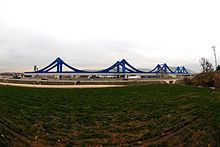Carries High Speed Railway Owner ADIF Total length 574 m | Opened 2006 Construction end 2006 | |
 | ||
Designer | ||
The Llinars Bridge this bridge is the first steel structure in the high-speed railway (HSR) joining Barcelona and the French Border. The 1883 ft (574 m) long Llinars HSR bridge comprises two parts: a 1008 ft (307 m) long composite steel–concrete structure crossing the highway, and a continuous prestressed concrete bridge crossing the Mogent River with a maximum span of 157 ft (48 m).
Contents
After analyzing many possible color combinations for the Llinars bridge, the designers selected blue for the members above the deck level and gray for the bottom of the longitudinal beams. This combination was intended to make the structure appear more slender.
Description
The 574 m long Llinars bridge comprises two parts: A 307 m long composite steel and concrete structure crossing tollway 7 and a continuous structure made of prestressed concrete crossing the Mogent River with a maximum span of 48 m. The location of the piers was dictated by the highly skewed angle of the highway crossing and by the launching process used to erect the bridge. The final bridge features a composite steel and concrete deck suspended on structural steel tied members.
Construction
Construction of the Llinars bridge began in 2003. An effort was made to develop an aesthetically pleasing solution that would be transparent and well suited to the site. To avoid interfering with the operation of Barcelona’s critically important tollway 7, incremental launching construction methods were used for the composite steel and concrete section. This section includes a deck that is a continuous structure with five spans.
The suspension members have a typical box girder cross section with an average depth of 1.7 m. The flange width, 1.6 m, does not vary along the girder. For aesthetic reasons, the members have a radius of curvature of 48.6 m, limiting the large structure’s vertical clearance over the highway and diminishing its visual obtrusiveness. A complex steel structure with innovative aesthetics. This High-Speed Rail Bridge required a complex dynamic analysis. The launching method used for construction avoided any interference with the traffic below and to complete the structure on time and budget.
